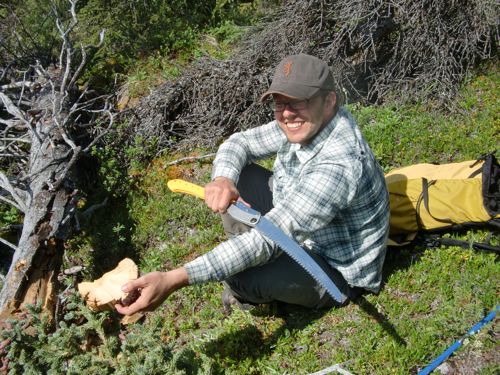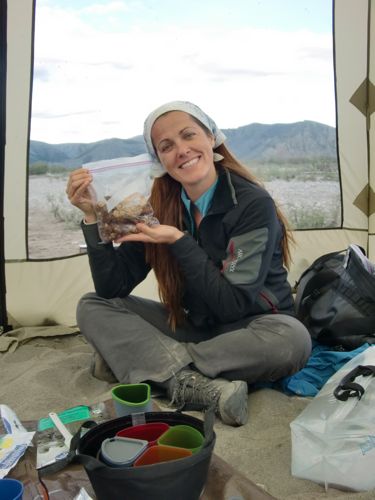Our weather has taken a decided change for the wetter, with occasional rain showers and gray clouds replacing our searingly sunny days. So, what can you do on grey days? If you're a dendrochronologist, like we are (well, two of us are dendrochronologists-in-training), you make cookies. Now, these are not some kind of special tundra chip wonder made from some crazy blend of flour, sugar, butter, and eggs. These cookies are made from trees using sharp folding saws and a little bit of upper bodywork.
 Kevin Anchukaitis and his special japanese folding cookie cutter.
Kevin Anchukaitis and his special japanese folding cookie cutter.
We are cutting our cookies from what is called sub-fossilized wood. This is, to me, funny dendro-speak for wood that is dead and lying on the ground. Since most of this wood will rot long before it has any chance of becoming fossilized, it is called sub-fossilized. At home I would call it 'dead and downed' wood. Either way, it takes a bit of work using our very sharp Japanese folding saws known as 'Big Boys' to cut these slabs of wood.
 I am taking a short break from this aerobic cookie-cutting activity.
I am taking a short break from this aerobic cookie-cutting activity.
Our cookies range in diameter from 2 inches to 6 inches--sort of the range of a gingersnap to a giant chocolate chip cookie. The ideal cookie is around 1 inch thick. Are you hungry for cookies yet?
 This tree cookie will be sanded and its rings counted and analyzed at the lab to supplement ring data from the cores we took from live trees.
This tree cookie will be sanded and its rings counted and analyzed at the lab to supplement ring data from the cores we took from live trees.
Each cookie is labeled with the site name and given a number. The site is Mancha Creek E, so each cookie gets MCR-E followed by its sequential number. By the end of 2 days of cookie cutting we collected almost 50 cookies. Sort of a dendrochronologist's Baker's Dozen. The cookies will be sent back to the Tree Ring lab at the Lamont Doherty Earth Observatory where the flat face will be sanded. Once the surface is flat and smooth, the cookie's rings will be examined under a microscope so that the number of rings and their widths and growth patterns can be compared with the core samples we took from live trees. This data will allow scientists to extend the tree ring record further back in time. On a previous collecting trip to the Firth River in 2002, sub-fossilized wood was collected that dated back over 400 years! That's some old wood for an area such as this.
By extending the tree ring record as far backward as possible, and comparing that with the most recent data from live trees, scientists are able to get some insight into how these trees are reacting to the changing arctic climate. While these cookies might not be as tasty as freshly baked chocolate chip cookies, they are certainly more enduring, more informative, and less filling!
 Wait-these are the wrong cookies!
Wait-these are the wrong cookies!
